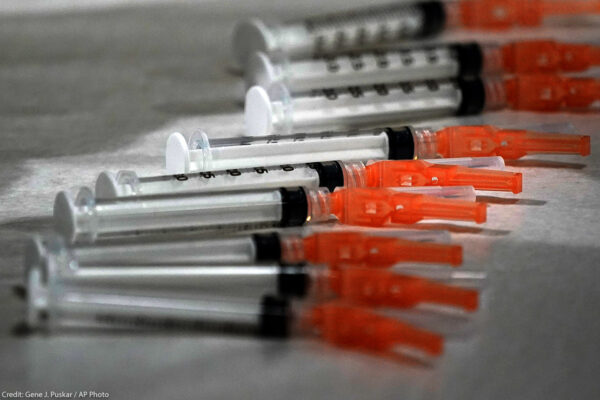Since the onset of the pandemic, COVID-19 has disproportionately devastated Black, Latinx, Indigenous, and Asian communities and now, these same communities are being left in the dust in the nationwide race to vaccinate. The racial disparities in hospitalization and death rates among these groups are mirrored in early vaccination rate data. Black people are two to three times less likely than white people to be vaccinated. While statistics like these are disheartening, we can and must do better. States should push back against these disparities by prioritizing outreach and access to the vaccine in geographic areas with the most vulnerable people.
The key to equitable vaccination lies in social vulnerability data, which includes variables such as race, language, socioeconomic status, and household composition. The Centers for Disease Control and Prevention (CDC) aggregates this information using census tract data, which enables the agency to measure the resiliency of communities and make geographically-based recommendations to local officials using their Social Vulnerability Index (SVI).
While the CDC has collected and used this data to anticipate and respond to environmental and public health crises since 2000, the index has become an especially crucial tool in the context of the COVID-19 pandemic. The data offer a path forward as localities seek to relieve the disproportionate burden borne by communities of color. Social vulnerability indices help experts identify neighborhoods most at risk for COVID-19 cases, hospitalizations, and deaths. Of all the variables measured, minority status and English language proficiency have the strongest association with COVID-19 deaths at the community level. Underlying health conditions alone cannot address the severe racial disparities in vaccination rates.
At least 26 states have announced plans to use or are already using SVIs in their vaccine distribution plans. Ohio uses the SVI to allocate the vaccine, while Arizona uses it to target outreach and communication plans. Tennessee and New Hampshire use the SVI to identify the most vulnerable geographic areas and to set aside a percentage of the vaccines for these counties.
This crucial data should be used in every state to ensure equitable vaccine access — a goal that states have fallen woefully short of thus far. Disparities in vaccination rates are plainly illustrated by health care worker data. Because the initial round of vaccines was primarily provided to these workers, the percentage of people vaccinated should align with the racial demographics of this sector. Yet despite making up a large portion of this workforce, Black people are significantly underrepresented in vaccinations.
In Mississippi, Black people comprise 37 percent of health care workers but only 15 percent of people vaccinated. Similarly, just 16 percent of people vaccinated in Maryland are Black, even though Black people comprise 42 percent of health care workers and 30 percent of the state population. Vaccination rates don’t match up with local demographics, either. In Philadelphia, just 12 percent of Black people were vaccinated, even though the population is 44 percent Black. Only 7 percent of people vaccinated in Miami-Dade County were Black, even though Black people “comprise almost 17 percent of the population and are dying from COVID-19 at a rate that is more than 60 percent higher than that of white people,” The New York Times reported.
Some of these disparities can be explained by systemic barriers to vaccine access in low-income communities and communities of color, such as the lack of technology, transportation access to vaccine sites, or ability to take off work. Many people in low-income communities lack the stable, high-speed internet access required to continue refreshing sign-up websites for appointments, and registration phone lines have notoriously long wait times and are difficult to navigate. Wealthy white people with more access to these resources have taken a disproportionate share of vaccinations provided in low-income communities of color. In Washington, D.C., 40 percent of vaccination appointments were made by residents of the city’s whitest, wealthiest ward.
Social vulnerability data is key to intentionally increasing vaccine access to those who need it most, but it should be coupled with other tools to counter barriers to vaccination. To combat skepticism and mistrust, states should increase culturally sensitive education about the vaccine, including community and faith-based outreach and marketing. States should facilitate non-computer registration for the vaccine. Further, states should expand locations for distribution to residents of the most vulnerable neighborhoods. This can include working with mobile health vans and community health workers, and offering vaccinations at federally qualified health centers, as well as community-based health care providers in underserved areas.
The best way to assess whether those who need the vaccine most are receiving it is through transparent and thorough data collection. States should collect and report vaccination data — consistent with all privacy laws and best practices — by various demographic factors, including race and zip codes of those who are vaccinated, to identify and eliminate disparities. Disparities were consistent in the 34 states that have released vaccination data by race to date. Black and Latinx people receive smaller shares of the vaccination than their proportion of the larger population and COVID-19 hospitalizations or deaths. Finally, states should conduct fact-finding hearings with testimony from public health, history, and economic experts to identify and remedy incidents of discrimination in the response to the pandemic.
Communities of color continue to bear the brunt of COVID-19, and this crisis has laid bare the impact of systemic racism in the U.S. Inequitable vaccine access is the latest manifestation of this ongoing problem. It is up to state officials to mitigate these racial disparities by using social vulnerability data to prioritize vaccine access and distribution to the most vulnerable groups.

